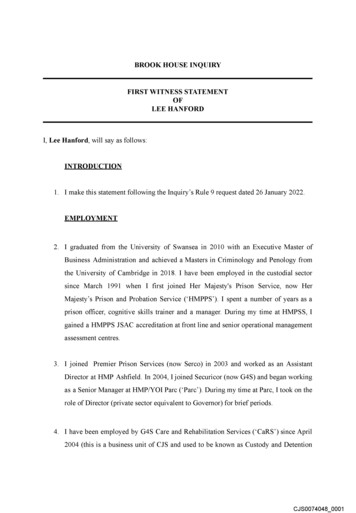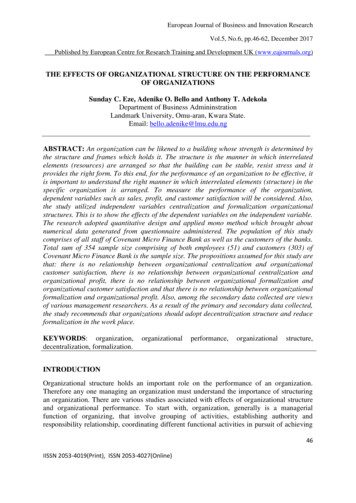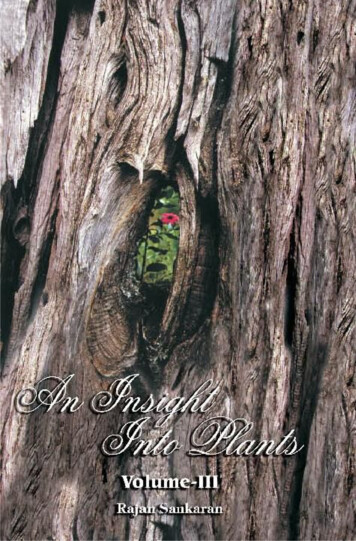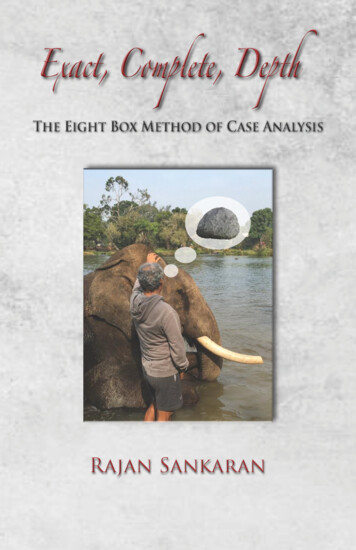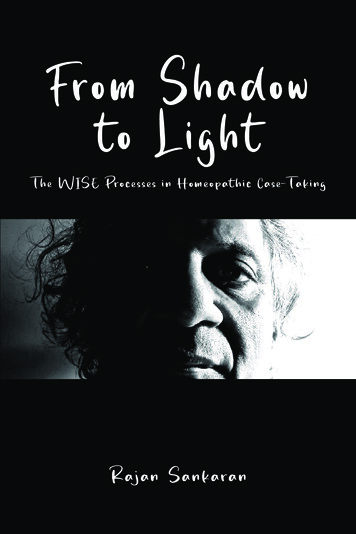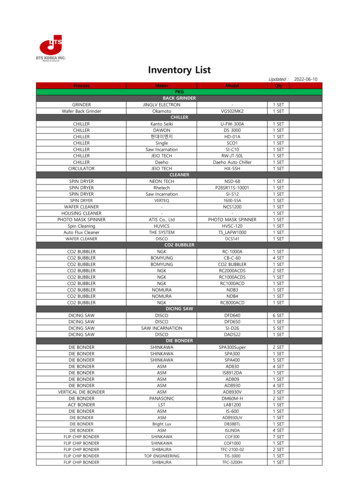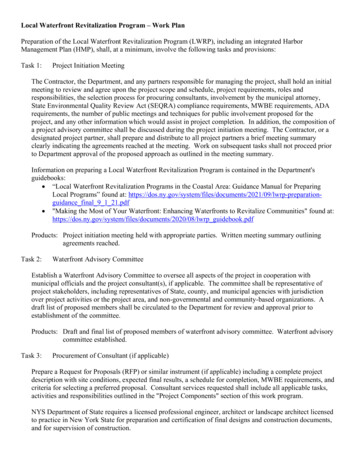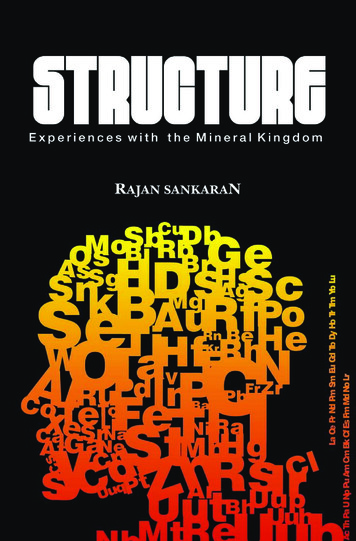
Transcription
6
STRUCTUREExperiences with the mineral kingdomVolume 1RAJAN SANKARANHomoeopathic Medical Publishers201 Dinar, 20, Station Road, Santacruz (W), Mumbai 400 054, IndiaTel: 91 22 2660 5680, Fax: 91 22 2660 5776, E-mail: spirit@vsnl.comwww.rajansankaran.com
Rajan SankaranAll rights reserved. No part of this publication may be reproduced, transmittedor translated into any language in India or abroad in any form or by any meanswithout permission of the publisher.Printed in IndiaFirst Edition: 2008ISBN–978–81–903378-8-5Designed by:Yashodeep Gholapgracestrokes@rediffmail.comPrinted byArun K. Mehta at Vakil & Sons Pvt. Ltd.,Industry Manor, Appasaheb Marathe Marg, Prabhadevi, Mumbai-400 025.Published byHOMOEOPATHIC MEDICAL PUBLISHERS201 Dinar, 20, Station Road, Santacruz (W), Mumbai-400 054, IndiaTel: 91 22 2660 5680, Fax: 91 22 2660 5776, E-mail: spirit@vsnl.comwww.rajansankaran.com
This work is dedicated toJan Scholtenin acknowledgement and appreciationof his cardinal contribution tothe understanding of the mineral kingdom.
CONTENTSVolume 17ACKNOWLEDGEMENT9LIST OF CONTRIBUTORS13FOREWORD15NOTE TO THE READER17INTRODUCTION21KINGDOM DIFFERENTIATION29THE RECOGNITION OF “THE MINERAL SONG”33MINERALS37MINERAL SOURCE WORDS43MINERALS – OVERVIEW OF THE ROWS53MINERALS – OVERVIEW OF THE COLUMNS89COLUMN 17 – HALOGENS107COLUMN 18 – NOBLE/RARE GASES131ROW 1191ROW 2307ROW 3Volume 2523ROW 4739ROW 5865ROW 6981ROW 71007MIASMS IN THE MINERAL KINGDOM(By Roger Morrison)1015METAL PRESCRIPTION IN PAEDIATRICS(By Patricia Le Roux)1027CHARTS5
AcknowledgementI gratefully acknowledge the contribution of the following to thedevelopment of ideas and the writing of this book:Jan Scholten for his development of ideas on the mineral kingdom,especially his study of the pattern in the 18 columns.Jeremy Sherr for his provings like Hydrogen, Germanium,Neon and others.Roger Morrison who has consented to write the foreword and contributedone chapter on Miasms and minerals. He has also helped in theunderstanding of Carbons. He has been a pillar of support.Paresh Vasani who worked with me on the Vital Quest and helped tosystematize the knowledge.Meghna Shah who worked with me in the clinic and on the cases.She has done much work for this book, in finalizing it, in polishing it,in bringing it all together so well.Julia Schiller who gave the finishing touches and did the final editing.Leena Sanghvi who contributed in putting all the information together.And all the following people whose cases and provings have beenincluded in this book and have helped added much value to it: LaurieDack, Sujit Chatterjee, Jayesh Shah, Mahesh Gandhi, Ingrid Van de Vel,Ilana Dannheisser, Bert Lefevre, Nancy Herrick, Bipin Gurjar, GabrielCampuzano, Robert Gramlich, Misha Norland, Divya Chabbra, JacquesEchard and Bill Mann.7
LIST OF CONTRIBUTORSBert Lefevre, M.D.Bert Lefevre, from Antwerp, Belgium, has been practicing Homoeopathy since 1993. Heteaches at the V.S.U. Homoeopathy School of Belgium and is also a guest lecturer atthe S.H.O. School of Homeopathy in Holland. He is a founding member of the “Samosa”study group and has been organizing Homoeopathic seminars since 2002. His website:www.homeopathy-antwerpen.be.Bill Mann L. Ac.Bill Mann has practiced in the healing arts since 1981, when he began studying atthe New Mexico School of Natural Therapeutics .He was introduced to the work ofDr. Rajan Sankaran in 1993 and attended numerous seminars with him since then,including the Bombay clinical workshops in India for International homoeopaths. Hehas lectured at many homoeopathic schools and helped found them (Desert InstituteSchool of Classical Homeopathy, Homeopathy Academy of Southern California, CurenturUniversity in LA, the Acupuncture and Homeopathic Institute in Miami and San DiegoCenter for Homeopathic Training), and conferences in Phoenix, AZ and Brattleboro, VTIn 2004, he founded the California Center for Homeopathic Education (CCHE).Bipin Gurjar B.H.M.S.Dr. Bipin Gurjar practices in Ahmedabad, India. He is also actively involved in organizingseminars and workshops. He has also attended various courses and seminars withDr. Rajan Sankaran. Dr. Bipin Gurjar is a very serious practitioner and an ardent followerof the Sensation Method. He is also a very dedicated student of Dr. Sankaran.Gabriel Campuzano P. M.D.Gabriel Campuzano P graduated as a medical doctor in México in 1983, he furtheredhis studies in Homoeopathy under PS Ortega in Homeopatia de México. After years ofpractice he left his home country and developed practices and lifestyles in Colombia,India, Romania and at last in Wales and Portugal where he lives and practices alreadyfor 15 years. Teaching homeopathy in Romania, Portugal and the UK has been partof his process of incorporating the latest developments in homoeopathy in the last15 years.9
STRUCTURE - Experiences with the Mineral KingdomIlana DannheisserIlana practices and teaches in the United Kingdom, and is the author of the book“Homeopathy - An Illustrated Guide”.Ingrid Van de Vel, M.D.Ingrid Van de Vel is from Belgium. She started studying Homoeopathy in 1998 at VSUand in 1999 started her practice in the center of Dr. Leon Scheepers, where she is stillworking. Since 2001 she has been organizing Dr. Rajan Sankaran’s video seminars alongwith Bert Lefevre. She was instrumental in organizing Dr. Sankaran’s “live seminar” in2005 in Belgium.Jacques Echard, M.D.He lives and practices in Tolouse, France. He organizes and teaches classicalhomoeopathy in several seminars and discussion groups.Judyth Reichenberg-Ullman, ND, LCSWJudyth is the author or co-author of seven books on Homoeopathy including thebest-selling Ritalin-Free Kids. She has been practicing since 1984 at the NorthwestCenter for Homeopathic Medicine in Edmonds, Washington. U.S.A. Her website iswww.healthyhomeopathy.com.Laurie DackLaurie Dack enjoys a full time Homoeopathic practice in Vancouver, Canada. Her studyand practice of Homoeopathy have taken her to Europe, India and the U.S. over thepast 19 years. She now teaches in Canada and the U.S.A.Nancy Herrick, MA, PANancy Herrick has been practicing Homoeopathy since 1975. Director of the NewHahnemann Medical Clinic, she also teaches classical homoeopathy to professionalmedical practitioners at Hahnemann College of Homeopathy. She has also beenlecturing throughout Europe, Asia, Australia, New Zealand and the USA for twentyyears. She is the author of two books on proving: “Sacred Plants, Human Voices” and“Animal Mind, Human Voices.”For more information, contact: jaffemarks@yahoo.comPatricia Le Roux, M.D.Patricia Le Roux, pediatrician consultant in Marseilles (France) runs a day practicein homoeopathy and has trained in homoeopathy in Marseilles Medical Universityqualified in 1995. She was taught and brought to classical homoeopathy by10
KingdomList ofDifferenciationContributorsDr. Didier Grandgeorge, homoeopathic pediatrician teacher in Marseilles universityalso president of the Fréjus classical school of homeopathy.She also works regularly as hospital practitioner as emergency pediatrician in thechildren emergency ward of the largest university teaching Hospital Timone (CHU) inMarseilles. She has published quite a few works in homoeopathy, first one on milks(Homeo et Juliette) then an important work on acids. This is has been published inthe book “Homéo-Hydrogen Energy”. Also qualified in medical Ethics, Patricia LeRoux, runs an ethical commission “Europe and Ethics” within the university hospital inMarseilles. Patricia Le Roux is also very active in the way of representation of medicaldoctors, as vice president of the French National Association (SNMHF) and at Europeanlevel as General Secretary of ECH (European Committee for Homeopathy).Robert Gramlich, M.D.Robert Gramlich completed his M.D. at USC School of Medicine in 1994 and his residencyin Family Practice at UCLA in 1997. He began study and practice of homoeopathy in 1993and has a clinic in Los Angeles. Right from the beginning he followed the teachings ofDr. Rajan Sankaran and his colleagues and what became known as the Bombay Schoolof Homoeopathy. He has been to India many times to precept in the clinics and wasone of the original participants of what has become the Annual Bombay InternationalSeminar.Roger Morrison, M.D.Roger Morrison began the study of Homoeopathy in 1978 under the direction of GeorgeVithoulkas. In 1985 he was a co-founder of the Hahnemann College of Homeopathy inBerkeley, California. His books include: Desktop Guide to Keynotes and ConfirmatorySymptoms, Desktop Companion to Physical Pathology, Carbon: Organic Compoundsand Hydrocarbon Remedies in Homeopathy.Sunil Anand, L.C.E.H.Sunil Anand is best known for his keen observation and unique approach in the normallydifficult area of pediatric cases. He has recently re-located to the city of Pune wherehe practices, teaches at the D.S. Homoeopathic Medical College and heads a clinic inPediatrics in Homoeopathy.Sujit Chatterjee, D.H.M.S.Sujit Chatterjee has been practicing Homoeopathy since 1983. He is one of the coreteachers of the Bombay School of Homoeopathy. He has also used 50 millesimalpotency brilliantly in his practice and conducted provings of remedies like Uraniumnitrate, Ficus religiosa, Ficus indica and Chocolate. Dr. Chatterjee has given severalinternational seminars in countries including the USA, Canada, Switzerland, Austria,Germany, and the UK.11
FOREWORDThose of us who have seriously and unprejudicedly followed the work of Rajan Sankaranover many years, have witnessed a flowering of insight and precision in theory, in casetaking and in prescribing. In recent years, Dr. Sankaran’s methodology and conceptualframework has matured into a coherent system (see his books, “Sensation in Homoeopathy”and “Sensation Refined”) that examines homoeopathic remedies from a systems approachrather than a mere collection of data. Through observation into the underlying unity ofremedies in various families of plants, animals and minerals, Dr. Sankaran found the keysto a more sophisticated and reliable method of finding the Similimum.The Sensation Method (also called the “Sankaran Method”) combines both a case-takingtechnique (devised and improved over many years) and an analysis technique which(when properly applied) pares to the bone all the normal human temptation to interpretthe evidence procured through case-taking. This astonishing accomplishment resultedfrom Dr. Sankaran’s relentless and almost ruthless effort to find the bedrock of humanexperience and especially as it pertains to the homoeopathic endeavor. By tracing thathuman experience to almost algebraic level, Dr. Sankaran has excavated and revealedthe underlying characteristics of the various families of remedies. Through the casetaking technique, the patient’s experience is revealed and, without interpretation, thepatient’s miasm, remedy family and source are simultaneously revealed. It should beemphasized that this method does not discard any previous knowledge of remedies butfrees us from the inherent flaws and inadequacies of our database. It is an achievementthat I believe Hahnemann would applaud.Not content with providing an intellectual framework for the practice of homoeopathy,Dr. Sankaran next began to fill in the details. This work began with accurate descriptionsof the characteristics of each plant family in his work, “Insight into Plants”. Thisthree-volume text presents the key sensations and characteristics of some 23 plantfamilies. I understand that a treatise on the animal kingdom is forthcoming. In thecurrent work, Dr. Sankaran has turned his attention to the mineral kingdom.This long awaited book deeply explores the nature of the mineral remedy – from nearlyevery vantage point:*Exact descriptions of minerals in general, from the most intimate and interiorexperience of the patient. This description includes clear guidelines for differentiatingthe minerals from plant and animal remedies.13
STRUCTURE - Experiences with the Mineral Kingdom*Precise definitions of each row and column of the periodic table. Building uponhis previous work on the minerals and upon the work of Jan Scholten, Dr. Sankaran hasdeepened and clarified our understanding of the rows and columns.*Detailed descriptions of each individual element and many salts. Whenpossible, Dr. Sankaran has provided his own experience of the individual remedieswith new and penetrating insights.*Dozens of case examples with transcripts of cases where the SensationMethod is applied.“Structure” is an exciting synthesis of the work of Jan Scholten and the SankaranMethod. The book is a necessary key, enabling those who follow Dr. Sankaran’s workto use the periodic table to greatest advantage. In addition, Dr. Sankaran’s insight anddescriptions amplify and extend our knowledge of the columns, rows and individualremedies vastly. Having utilized these insights in my own practice I can attest totheir accuracy and almost uncanny relevance to case taking. At times I have almostsuspected my patients of having studied Dr. Sankaran’s lectures because their wordsare identical to his descriptions.The ultimate test of any homoeopathic work: Do the descriptions and explanationsmatch clinical experience and aid us in bringing cure? I can say with perfect confidencethat the experienced homoeopath who applies the principles contained in this book willfind great satisfaction. This work opens up possibilities of cure in cases that otherwisewould go unsolved. It brings light to many areas of mystery and confusion. This bookis a treasure.Roger Morrison M.D.14
NOTE TO THE READER1.Cases to follow in the book are either edited for brevity or grammatized for betterreading.2.Some abbreviations used as follows:D:PhysicianP:PatientFa: Patient’s fatherMo: Patient’s motherW: Patient’s wife3.In between cases all the comments by the physician are in italics. Some cases alsohave highlighted in bold the important features.4.Keywords which hold the most importance are only mentioned in the chapters.5.Few cases are illustrated in depth for the reader to appreciate the process.6.Some cases enclose detailed follow-ups to enable the reader understand the finerchanges occurring at different levels in the case.7.In order to present a complete picture of remedies I have included excerptssummarized from my earlier books.8.References of rubrics mentioned with prevalence of remedies as per the discussedtopic.9.Properties of elements and some other information related to physiology processand anatomy are extracted from internet.15
INTRODUCTION
STRUCTURE - Experiences with the Mineral KingdomHomoeopathy has progressed from a symptom-based approach to a systematicapproach where remedies are a part of groups that belong to nature rather thandiscrete identities.The first kingdom to be classified this way was the mineral kingdom. The progressfrom symptom to system in Homoeopathy began with the exploration of the mineralkingdom. Organized according to structure, the mineral kingdom is most amenable toa systematic approach.Even a cursory look through our Materia Medica reveals similarities between Palladiumand Platinum or Kali and Calcarea, both of these pairs being next to each other on theperiodic table.Farrington was one of the first homoeopaths to study remedies in groups; later onM.L. Dhawale and his colleagues in the ICR did some excellent work in this field.In 1991, I started examining the periodic table to look for patterns in the remediesand I found for example that remedies in the second column — Magnesium, Calcarea,Strontium and Barium — had a strong theme of dependence. Each is dependent in adifferent way that represents a certain stage of human development.For example:kMagnesium is like an infant.kCalcarea is like a child.kBarium is like an adult who is unable to take responsibility.I hypothesized that Strontium, being between Calcarea and Barium, should havedependence like a teenager who needs guidance. To test out this hypothesis I conducteda proving of Strontium carb and all of the provers (who were unaware of what they wereproving) spontaneously brought out the need for guidance and a need for a guide (fora more detailed understanding of the proving please refer to ‘Provings’).Thus I understood that in the Periodic table each row represented a further stage ofhuman growth and development.In other words the periodic table is itself a map of human development. Later Iunderstood that the mineral remedies themselves have to do with ‘Structure’.(Whereas plants remedies are about sensitivity and animals about survival.)Structure has two aspects or parts:18kForming and developingkDisintegrating and breaking
IntroductionIn my 1991 book, ‘The Substance of Homoeopathy’, I gave a rough framework ofunderstanding a system within the periodic table. I observed the patterns and thethemes within the rows and columns. To fill the gaps in my understanding, I conductedprovings of several elements such as Ferrum, Iodum, Strontium carb and Niccolum.Jan Scholten did some path breaking work in this regard, especially on the idea of therise and fall within each row. He introduced the concept of how each row begins withremedies that feel no capability, then peak to success in the 10th column and then losethe capability progressively from then on through the 17th column. His work has beenvery useful and helped us to prescribe several remedies for the first time, bringing moreelements of the periodic table into Homoeopathy.In 2003 after a gap of nearly 10 years, while drawing clues from Scholten’s works, inmy practice I tried to observe and understand the periodic table for myself and usedthese ideas with gratifying results. What resulted was a detailed understanding ofthe periodic table as a map of human development from womb to tomb. Eachrow represented a certain stage of human life and each column represented thedevelopment within that stage.We started teaching these cases and sharing these ideas in seminars. People foundthem useful and urged me to write them down. This could represent simply anotherway of looking at and expressing these concepts and ideas about the periodic tableand may help practitioners in clarifying the whole picture.This understanding has been informed by several approaches, firstly studies of individualelements through proving, repertory, clinical material and my own cases for the past25 years. Secondly common symptoms of a particular row were yielded through useof repertory software programs, especially the Mac repertory. Thirdly, a study of thesource words of patients using the sensation method, which I discovered in 2001. Wenow have source words for minerals in general and for each row and column. Fourthly,a study of the life situation in those stages of life which each row represents identifiedrepertorial correlations i.e. applicable rubrics. The understanding that resulted led me toperceive the rows and columns in as pure a form as possible, without using patients’delusions, situations, etc. to understand them, since I believe that to understandsomething through the human filter is often interpretative and risky. This understandinghas been confirmed in several cases and it is such a joy to watch patient after patientrepeat almost word to word of this understanding.It is my pleasure to offer this work to the profession, so that it may help more patientsto be restored from sickness to health. Your feedback and your cases are mostwelcome.19
STRUCTURE - Experiences with the Mineral KingdomLooking beyond the Delusion:The understanding of the plant families via sensations was like a huge breakthroughin my understanding of disease, and as has already been explained, my earlier ideasabout disease being a delusion and the subsequent emphasis on the mental state havesince undergone a metamorphosis.Around 1990 a question occurred to me: Is it possible that a person who needsa plant remedy is somehow different from one needing an animal or mineralremedy? This simple line of inquiry was rather novel in Homoeopathy. And fromsomething which seemed so simple in the beginning came a radical shift in mypractise. I soon realized it was like unearthing one of the most innate truths inHomoeopathy because it brought to light a completely new insight into remedies.And for the first time in my understanding Homoeopathy became system-basedinstead of symptom-based.Traditionally we only selected remedies according to symptoms. But then this wouldlead to several different remedies, often from different kingdoms.Let us take a simple hypothetical example with the following symptoms:kMind; grief, sorrow agg.kMind; weeping, tearful mood; general; alone, being; agg.kMind; consolation; agg.And we come to our well known Ignatia and Natrum muriaticum. But now what do wedo? Which remedy to select? We often face similar puzzling situations. So in orderto avoid these difficult and perplexing situations where we get so confused in ourselection of remedies, I realized that we needed to categorize our remedies, basedon fundamental principles, not on sheer suppositions and presumptions. That wayyou do not just think of remedies matching symptoms but rather systematize thesymptoms you get. And for this the foremost and the most important question thatshould strike your curious mind each time is, ‘Is it the plant, animal or mineral kingdom?’And once this question gets answered cases become very simple to understand andremedies become crystal clear.But this was not the end for me, as there was still more to this mysterious quest. Asthis kingdom classification unfolded to me an entire world outside Homoeopathy, i.e.the source world of the remedies.This is an attempt to know remedies not just as a mere collection of randomly selectedsymptoms but to understand them beyond the physical/ local symptoms, or mental/22
STRUCTURE - Experiences with the Mineral KingdomThe central features of the mineral kingdom are its structure and organization. Theseare the features that help scientists understand this kingdom so well. The structure ofminerals is ordered and predictable in many ways, allowing an exact classification of allelements into the Periodic Table. It is this structured organization inherent in all mineralswhich makes chemistry an exact science.We find these features of structure and organization in persons who’s “Other Song”coincides with the energy of a mineral. The first impression one gets on seeing such aperson is that he is very well organized. Even the clothes that he wears are characteristic:symmetrical patterns, stripes, checks or plain. His speech is planned, giving a sense ofexactness and precision. His hands tend to be either folded across his chest or restingcomfortably without much movement. His voice and tone are quite flat without manyfluctuations in the pitch. He presents his story or complaints (at a doctor’s clinic) in avery systematic manner, often beginning with the previous follow up and then speakingof subsequent events almost chronologically: “I came to you last on.for the first sixdays, the pain in my ”. I have observed that very often such a patient notes down hissymptoms in carefully written points, and describes each symptom completely (in asmuch detail as he thinks necessary) before going on to the next symptom. He perceivesand therefore describes things in an ordered manner. For instance, once treatmentstarts, he describes his progress at follow-ups in terms of percentages: “I am 25%better.” His hand-writing is usually well structured, straight (not rounded), and angled.And he speaks precisely and to the point.All these characteristics are due to a certain attitude of the mind and a structuredthought process. Consequently, the profession such an individual chooses will be onefor which he is best suited. He becomes an engineer, accountant, computer consultant,or business manager. He can be a high performer and makes a mark in his chosenfield in a steady, stable and reliable manner. Whatever his/her role, be it as a motherlooking after her children and home, or as a manager of a large corporation, thesesame characteristics of order and efficiency will be apparent.He gives prime importance to structure in all spheres of his life – be it in his family,his relationships or his profession. His performance in all areas relates to this innersense of structure, or lack of structure. He has issues around the security (of structurerelationship) that he has and that he can provide. The role of structure in human life isin building a society, in forming a family, and in developing an organization.If this is his “Other Song” then the human being will view all his problems through theprism of structure.His main problem is therefore around deficiency in or loss of structure. The precipitatingproblem could be a fragile or a broken relationship, the loss of a job, other financiallosses or any failure in performance. (In short, any threat to or failure on his part to30
STRUCTURE - Experiences with the Mineral KingdomThe main issue in minerals is about ‘Structure’ where the main concern is about lackingor formation or maintaining or losing structure.Structure is understood in terms ritykPerformancekResponsibilityThe issue is about completeness or incompleteness (like something is missing orlacking) in the self or structure, or a fear of losing that completeness. ‘Am I stableor unstable? Do I need to join with something else to become stable?’It can be:— lack of identity— lack of stamina— lack of support— lack of confidence— lack of a relationship— lack of security— lack of position or powerFor minerals, the problem is not with the opposite person, it’s with himself. Forexample, they would say, ‘I have to take what he does to me. If only I were independent,if only I were complete, then there would be no problem. It is my insecurity that leadsto the problem.’Mineral remedies are parallel to our understanding of the various stages ofhuman development, like how relatively developed or undeveloped we are. This Iunderstood by studying the periodic column with each row and column as a stage ofhuman development, starting from row 1 which mirrors the stage of conception to row7 which is about disintegration, and also each column (from 1 to 18) corresponding tothe individual phase of development of that row.34
MineralsTHE PERIODIC TABLE AND HUMAN DEVELOPMENT:In my search for a more consistent method and results, I understood the need toexplore deeper levels in any given case. Starting with the idea of Central Disturbance,I explored further to discover the significance of Delusions. Later the idea of Kingdomclassification followed and this was like an opening of a completely new frontier toa different perspective of Homoeopathy. The progress led me to the discovery of theSeven Levels of Experience (Name, Fact, Feeling, Delusion, Sensation, Energy andthe Seventh). This systematic approach to Homoeopathy greatly complements thesymptom approach.On similar grounds I also understood Minerals on the basis of the periodic table. In thepast few years since the understanding of the seven levels, I felt the need to perceivethe elements too at a non-human-specific level, at a sensation level. I understoodthat the elementary issue of mineral remedies is structure. The periodic table is arepresentation of the development of structure. It must then somehow also reflect thedevelopment of the human being.A study of remedies in each row confirmed that we were on the right track. As onemoves downward through the periodic table, each row reflects different stages ofdevelopment, from conception in row 1 to disintegration and preparing for death in row7. For patients needing mineral remedies, we could see how the particular qualities ofone of the stages of human development rose to the fore in the case-taking, enablingus to pinpoint the row to which their remedy belonged. Once that was identified, wecould consider how relatively developed or undeveloped they were regarding the issuesparticular to that row, enabling us to identify the column. In general, remedies on theleft hand side of the periodic table experience a feeling of lack in their structure, in themiddle they will be successful and on the right hand side they will feel as if they arelosing or have lost their structure.Summarizing the mineral features:kA certain problem of structure. The type of structure will represent the row towhich the patient belongs (e.g. row 3 has the issue of identity, row 4 has theissue of security, row 5 has the issue of going into something new, etc).kLacking structure (e.g. lacking the security or not feeling secure enough, cannotprotect oneself enough). They see themselves as parts and not as a whole.When there is a problem it is like one part is not working. Their efforts are tomaintain their structure despite this flaw in the system.kDifferent stages of development of the structure. Instead of relating events,there will be a focus on ‘what I have and what I don’t have’. (e.g. Calcarea willsay “I am secure in a normal condition but if there is a threat, I need support,backing.” Chromium would say “It’s a challenge for me to protect my positionat work, I have to take risks even though I am not prepared enough”.)35
STRUCTURE - Experiences with the Mineral KingdomAs mentioned earlier, it has been my endeavor to understand mineral remedies in termsof sensation, source language and non-human expressions.During case taking when you reach the sensation level, you start hearing the languageof the source. And this is just incredible! Because when you arrive at this point, you arequite confident the patient will do well. A kind of certainty creeps in, which one didn’tfeel so strongly after using the repertory and materia medica. In my understandingit is very important to know the king
Dr. Rajan Sankaran. Dr. Bipin Gurjar is a very serious practitioner and an ardent follower of the Sensation Method. He is also a very dedicated student of Dr. Sankaran. Gabriel Campuzano P. M.D. Gabriel Campuzano P graduated as a medical doctor in México in 1983, he furthered his studies in Homoeopathy under PS Ortega in Homeopatia de México.

